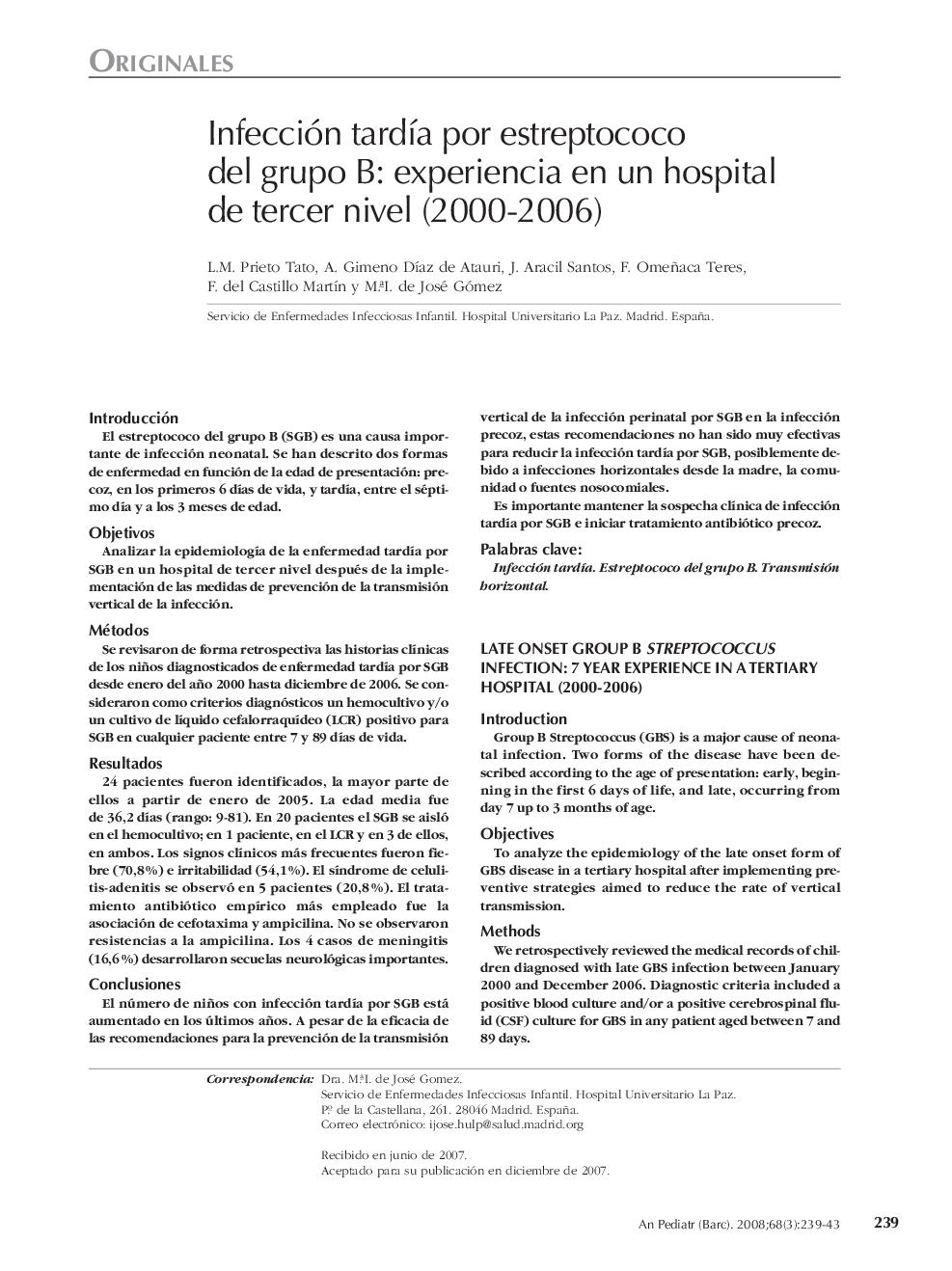| کد مقاله | کد نشریه | سال انتشار | مقاله انگلیسی | نسخه تمام متن |
|---|---|---|---|---|
| 4143253 | 1272401 | 2008 | 5 صفحه PDF | دانلود رایگان |

IntroducciónEl estreptococo del grupo B (SGB) es una causa importante de infección neonatal. Se han descrito dos formas de enfermedad en función de la edad de presentación: precoz, en los primeros 6 días de vida, y tardía, entre el séptimo día y a los 3 meses de edad.ObjetivosAnalizar la epidemiología de la enfermedad tardía por SGB en un hospital de tercer nivel después de la implementación de las medidas de prevención de la transmission vertical de la infección.MétodosSe revisaron de forma retrospectiva las historias clínicas de los niños diagnosticados de enfermedad tardía por SGB desde enero del año 2000 hasta diciembre de 2006. Se consideraron como criterios diagnósticos un hemocultivo y/o un cultivo de líquido cefalorraquídeo (LCR) positivo para SGB en cualquier paciente entre 7 y 89 días de vida.Resultados24 pacientes fueron identificados, la mayor parte de ellos a partir de enero de 2005. La edad media fue de 36,2 días (rango: 9-81). En 20 pacientes el SGB se aisló en el hemocultivo; en 1 paciente, en el LCR y en 3 de ellos, en ambos. Los signos clínicos más frecuentes fueron fiebre (70,8 %) e irritabilidad (54,1 %). El síndrome de celulitis-adenitis se observó en 5 pacientes (20,8 %). El tratamiento antibiótico empírico más empleado fue la asociación de cefotaxima y ampicilina. No se observaron resistencias a la ampicilina. Los 4 casos de meningitis (16,6 %) desarrollaron secuelas neurológicas importantes.ConclusionesEl número de niños con infección tardía por SGB está aumentado en los últimos años. A pesar de la eficacia de las recomendaciones para la prevención de la transmisión vertical de la infección perinatal por SGB en la infección precoz, estas recomendaciones no han sido muy efectivas para reducir la infección tardía por SGB, posiblemente debido a infecciones horizontales desde la madre, la comunidad o fuentes nosocomiales.Es importante mantener la sospecha clínica de infección tardía por SGB e iniciar tratamiento antibiótico precoz.
IntroductionGroup B Streptococcus (GBS) is a major cause of neonatal infection. Two forms of the disease have been described according to the age of presentation: early, beginning in the first 6 days of life, and late, occurring from day 7 up to 3 months of age.ObjectivesTo analyze the epidemiology of the late onset form of GBS disease in a tertiary hospital after implementing preventive strategies aimed to reduce the rate of vertical transmission.MethodsWe retrospectively reviewed the medical records of children diagnosed with late GBS infection between January 2000 and December 2006. Diagnostic criteria included a positive blood culture and/or a positive cerebrospinal fluid (CSF) culture for GBS in any patient aged between 7 and 89 days.Results24 patients were identified, most of them presenting after January 2005. Median age was 36.2 days (range 9 to 81). GBS isolates in blood were found in 20 patients, 1 in CSF and 3 in both. Most frequently children presented with fever (70.8 %) and irritability (54.1 %). Five patients (20.8 %) had a cellulitis-adenitis syndrome. Cefotaxime and ampicillin were the most often used antibiotic combination. No ampicillin resistances were found.ConclusionsThe number of children with late GBS disease has increased in our center. Accordingly, the recent recommendations for the prevention of perinatal GBS vertical transmission were not effective for reducing late GBS infection. This may be due to horizontal infections from maternal sources, community or cross infections. It is important to maintain clinical suspicion of late GBS infection and start early antibiotic treatment.
Journal: Anales de Pediatría - Volume 68, Issue 3, March 2008, Pages 239–243